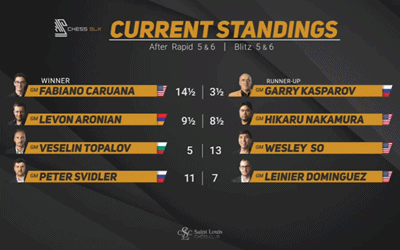The format of round one (Day 1) through round three (Day 3) was two rapid games followed by two blitz games, all games in each round having the same start position (SP). Even though I've been playing chess960 since 2008, I was impressed by how entertaining the Showdown games were. There was no explanation of the subtleties of the Najdorf Variation through move 15, no referring to a database of previous games to discover where the first original move was played. There were just some of the top chess players on the planet slugging it out from the first move in positions that have never been explored.
After watching Day 1, I skipped ahead to Day 4 where a different format was used. One SP was selected for four blitz games, followed by another SP for four more games, making eight games total for the day.
The results of the four matches for the first three rounds are shown in the following chart. The rapid games counted for two points, while the blitz games counted for one point. That meant each round had been worth a total of six points. The eight blitz games in Day 4 would be worth eight more points.

The chart shows that two of the matches were effectively decided, one was close to decided, and the fourth was a real tussle. GM Nakamura had come back from a 5-1 drubbing on the first day to trail GM Aronian by a single point. The commentators naturally focused on the Aronian - Nakamura match. The Caruana - Kasparov match had been the focus of attention in the previous rounds.
Day 4 started with a curiosity. The first start position (SP784 BBRQKNRN) was the twin of the position on Day 3 (SP175 NRNKQRBB). This meant that the initial piece development for SP784 repeated the considerations for SP175. The SPs would differentiate at the time of castling. • NB: After choosing the Day 4 position, TD Tony Rich called it 'SP779'. He was using the Chessgames.com Random Position Generator, which does not follow the standard numbering.
Before writing this post I hoped to gain additional insight into chess960 opening strategy, aka meta-theory. Instead I gained an appreciation for chess960 as a spectator. In Commentating the Opening in London (March 2013), I surmised,
This is exactly the attraction of Fischer's greatest invention. Everyone -- whether player or commentator or spectator -- is looking at the position for the first time ever, applying their own knowledge of chess to tackle a completely new chess position. Chess might not be a great spectator sport, but chess960 might well be.
Looks I got it right that time.

No comments:
Post a Comment